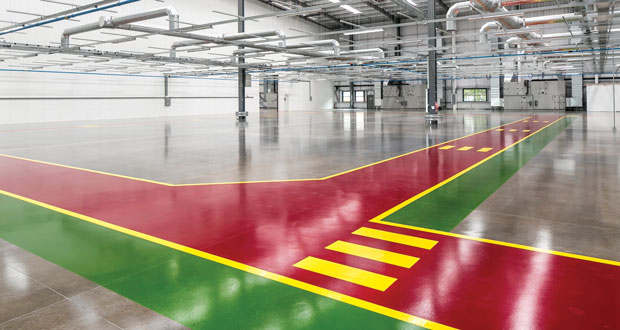Scott Saunders, Technical Service Manager at Watco, discusses how facilities managers can maximise the 5S approach within their sites to help streamline facility processes, as well as create a safer working environment.
Ever-increasing workloads and time-pressures are posing huge challenges for facilities managers. Watco’s latest research found that FMs are struggling for time to complete their tasks, and what’s more, their lists are ever growing. In fact, almost a third admitted that they have experienced an increased workload over the past year.
It’s not just internal pressures that FMs are facing. Businesses are increasingly operating in a more competitive environment which requires them to work faster, perform more efficiently and ultimately be more productive.
This constant pressure means facilities managers are continuously having to find ways to do their jobs more efficiently. The solution could be in lean warehousing and optimising the 5S system.
What is lean warehousing and the 5S system?
Lean warehousing is a management approach that limits resource consumption without sacrificing quality or productivity. In other words, it aims to streamline operations.
This approach utilises the 5S system: Sort, Straighten, Shine, Standardise, and Sustain. The 5S system originated in Japan and was first developed in the automotive industry, but it now has an essential role to play in achieving a lean workplace across all industries. In practice, these steps help identify, manage, and maintain procedures and processes that optimise functions and eliminate any which are not needed.
Taking a lean approach allows facilities managers to recognise what is important and what processes they could minimise, ultimately leading to lasting changes that maximise workflow. Adopting lean warehouse tactics and using the 5S system can help a facilities manager prevent overstocking, simplify its operations, and minimise touchpoints to keep everything running smoothly. Implementing this management system also helps businesses remain agile so that operations can adapt in line with business need.
Implementing lean warehousing in a facility: Sort and straighten
The first steps of 5S are all about organising the space. Line marking, colour-coding and sign posting are some of the simplest but most effective tools to ensure the space in your facility is being maximised. Doing this well also means that whether or not someone is new to a facility, they will be able to move around it with ease. This helps create a more productive space to work in and, more importantly, helps keep employees safe.
In facilities where employees and visitors have to navigate hazards, such as heavy machinery and working at height, having a defined line marking system is crucial to avoid accidents. Line marking, paint and symbols can be used to create clear signage of the emergency exits, passageways with automatic doors, and areas of heavy traffic.
It can also be used to map out one-way routes, production areas and storage areas. This in turn provides workers with a logical layout that saves them time and prevents any disruption to the flow of existing traffic.
The two most common methods of achieving a well-structured system are tape and paint. Tape is easy to place and remove in order to reconfigure a layout, particularly for one-off temporary layouts or areas in which the layout is frequently redesigned. Solutions like Watco’s Heavy Duty Line Marking Tape are an extremely durable option, able to withstand heavy traffic and high footfall.
For more permanent markings, paint is a strong contender. It’s easy-to-clean, long-lasting, and gives the opportunity to add an anti slip coating like Watco Safety Coat, a two-part epoxy resin with large finely textured beads, providing extra grip underfoot whilst also being easy to clean.
Next up: Shine
As well as increasing the organisation of a space, keeping facilities clean is another key component of the 5S method. According to HSE Statistics (2022/23), the most commonly reported non-fatal injury to employees across all industry sectors resulted from slips and falls on the same level (32%). In some cases, this can result in serious accidents and lead to costly claims.
Good housekeeping and a well maintained premises not only creates a pleasing place for staff to work, it also provides a safer environment and contributes to improving workplace productivity and efficiency. So, it is important for FMs to use the 5S method to help identify and tackle the most common slip hazards.
For many facilities, smooth painted floors can pose issues. While they may look clean and dry, a few drops of oil or grease could quickly lead to a nasty accident, especially if it has been spread around on shoes and tyres. They can normally be tackled with a strong detergent, but sometimes you need something with a bit more power. In these instances, a strong degreaser that’s powerful enough to break down and remove the grease, such as Watco Bio D, is the best solution.
While it is vital to clean spills as soon as they are spotted, in a busy facility with heavy traffic, this isn’t always practical. To avoid FMs having to spend all their time mopping, a slip resistant coating like Watco Safety Grip will help minimise the risk of accidents in areas that are prone to heavy contamination and prevent falls before someone has had a chance to clean the spill.
The final piece to the puzzle: Standardise and sustain
The true benefits of 5S cannot be felt by FMs unless processes are also standardised and sustained. To maximise the impact, it is vital to have all employees who use the space educated and onboard with the new processes.
This can be achieved by making it clear to all employees what needs to be done and specifying individual responsibility for each task and how regularly they need to be completed. This removes confusion regarding ownership of responsibilities so that important jobs aren’t missed and helps ensure these processes are long-lasting.
Ultimately, embedding 5S as part of daily tasks requires relatively low investment but the results are high impact, including improved organisation, sustained cleaning routines, and more efficient ways of working. This in turn allows facilities managers and fellow employees to improve their overall work environment, leading to improved workplace wellbeing and motivation, as well as increased efficiency and productivity.
-ends-
The view or information contained within these unedited press releases, are that of the company producing it and not necessary the views of kpm.





